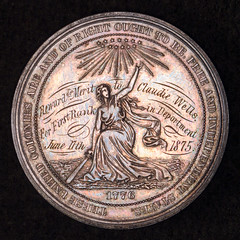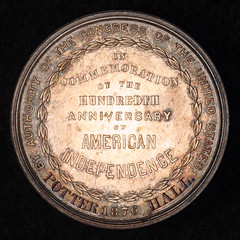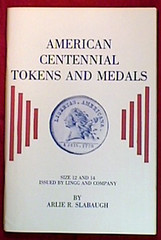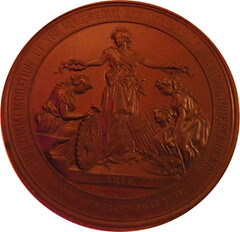
PREV ARTICLE
NEXT ARTICLE
FULL ISSUE
PREV FULL ISSUE
MORE ON A CABINET OF CENTENNIAL MEDALSRegarding Ron Abler's new book on Centennial Medals, John Sallay writes: Publishing your book electronically -- with the capability to edit and amend it over time – is a fantastic evolution in the development of numismatic literature, and I’ll be watching this project closely. Two of my three kids work in the publishing industry (including my older son working on the Kindle at Amazon), so I’m becoming a student of the business. As I think about how to eventually write and publish my own book on school award medals someday, I’ve begun exploring many of the issues you’ve identified, such as how to get feedback and incorporate new information in real time, how to handle the numbering system as new pieces are discovered, and how to make the economics work on a book of extremely narrow but deep interest. I wish you the best of luck, and will be happy to compare notes with you as the project evolves. I thought I’d send you photos of a medal from my collection, showing a small silver U.S. Mint medal that has been skillfully engraved to be used as a school award. The medal is still in its original case and undoubtedly would have been highly appreciated by the recipient during the big centennial celebration year. I’ve seen only one similar item, on eBay a year or two ago in pretty beat-up condition, so I think it’s a scarce item.


Arlie Slabaugh wrote of the Lingg Company tokens at the Centennial. The book is unavailable anywhere. (We published the book). Dick Johnson writes: I am very impressed with Ron Abler's new book. At first I thought it was overkill, but the deeper I get into it I realized the attention (and devotion!) the author has devoted to his chosen subject, The color illustrations are superb. I like the size -- enlarging small items, reducing large ones -- to one uniform size. The exact size in millimeters is given in the descriptions. The size in sixteenths (and conversion chart in the appendix) are now considered obsolete. A reader must divide that number by sixteen to come up with inches, and convert the remainder to a number of fourths or eighths or sixteenths. How much better to give diameter dimensions in inches (we Americans think in inches) but numismatists like the accuracy of millimeters (down to a tenth of a millimeter -- as Ron has done in his descriptions). I like to give both in my medal descriptions. Generally the dimension of the thickness of a medal is less important than its diameter. Thickness is a result of the gauge of sheet metal from which the blanks are cut. In any batch process sheets often vary in thickness, particularly when selected at different times. In early discussions with Ron I saw he was gathering his catalog data in spreadsheet form. I am pleased he presented his descriptions in straight text. (Spreadsheets have the tendency to discourage the compiler for the empty cells where the data is not available. Checklists are far better. Record what is available.) I will send Ron some suggestions for his glossary, correcting "Attributes" and "Legend." I'll suggest a definition of "Bronzing" and omitting of "Allotropes of Tin" (no one will seek out that term if they go to "Tin Pest" first. I'm looking forward to second and subsequent reading of Ron's book. If it was in paper form the pages would soon get dog-eared as I refer to it countless times.
I actually got that medal because it was in astonishingly high grade and was beautiful. I have a cased a gilt type I 57 mm medal so this is an excellent companion to that piece. I have to say that Ron's discussion about Centennial medals and his enthusiasm for the subject matter is rather infectious and it certainly shows in his new iBook. Author Ron Abler writes: I have received over thirty emails either directly from the E-Sylum article or from A Centennial Cabinet’s Contact page. John Sallay's note was among the first to arrive. So far, readers have been very supportive of the iBook concept, and I’ve already received enough corrections and new information to merit a “second edition” on Monday. From my perspective, the iBook is working exactly as I had hoped. I’ve asked John for permission to use images of his A40 engraved as an award medal. Mike Packard suggested an interactive Table of Contents that would mirror the printable TOC but allow single-point navigation throughout the entire website. I’ll put that in the third edition. Dave Baldwin pointed out that he has A2720 in brass, and he provided a missing image of the A550 reverse. Joe Levine has sent me a CD of the Centennial entries from his huge database, curious to find out what I can find to add to the site. William Waychison has given me a wealth of new (to me) information on A2620 and A2580. Jeff Smith has offered several images I do not have, and he thinks he has a medal not in the book (yet). Pete Smith sent an entire page of typos and additional information that I have already inserted into the Centennial Woods drawer. And, I was able to answer a question that Tom Casper had about the identifying characteristics among A1050-1070. In short, the iBook concept is working. There have been 111 visits to the site from 63 unique visitors, almost all thanks to The E-Sylum and your kind announcement, for which I thank you. I have added a Users’ Forum to the site, and it will be tested with the second edition. I’m hoping that it will be of service to collectors who want to share ideas and maybe ask questions that I can’t answer. I also have to add a new page that will explain how “editions” (actually, configurations) will allow tracking changes as the iBook matures.
Last week's issue had a typo in Ron's email address. Sorry! We'll fix our archive, and here's the correct address:
tritoncollect@atlanticbb.net.
-Editor
To read the earlier E-Sylum articles, see:
NEW BOOK: A CABINET OF CENTENNIAL MEDALS
(www.coinbooks.org/esylum_v16n47a03.html)
The Numismatic Bibliomania Society is a non-profit organization promoting numismatic literature. See our web site at coinbooks.org. To submit items for publication in The E-Sylum, write to the Editor at this address: whomren@gmail.com To subscribe go to: https://my.binhost.com/lists/listinfo/esylum All Rights Reserved. NBS Home Page Contact the NBS webmaster 
|

